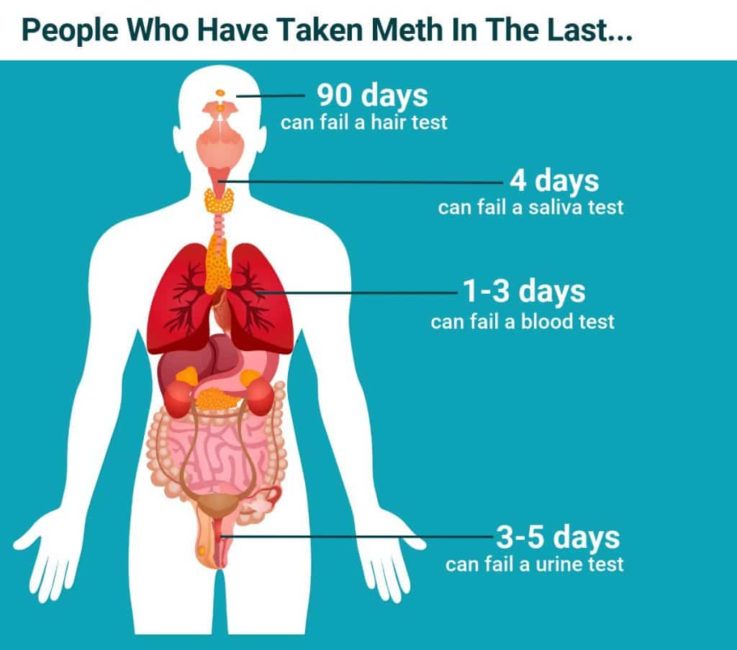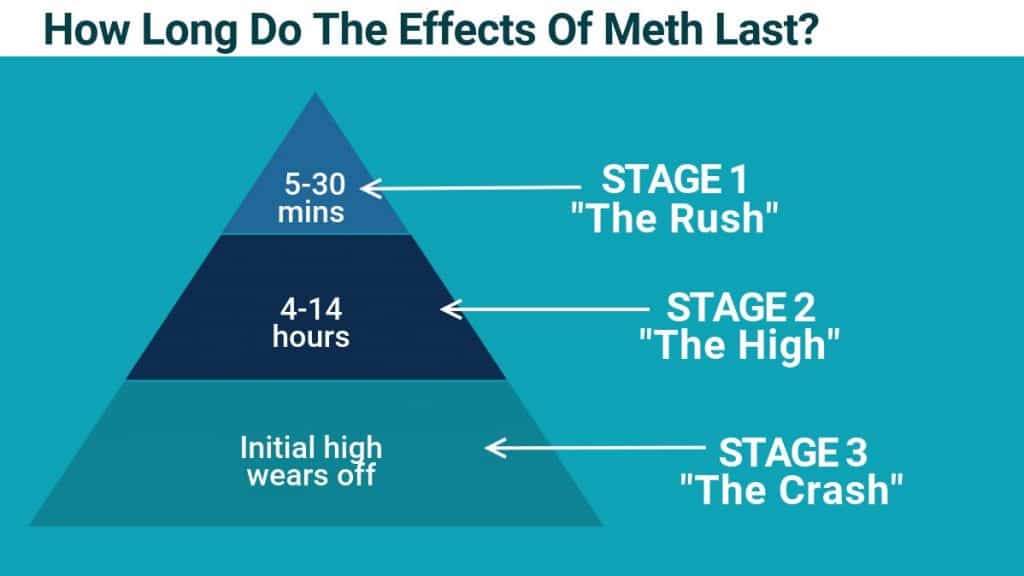Meth can be detected in urine, blood, saliva and even hair for different periods of time that vary from person to person. In general, it’s much longer than you’d expect.
Although the high from meth may last only a few minutes to a few hours, the drug can remain in your body for a much longer period of time. Even after the high wears off, your liver remains hard at work breaking down the substance so that it can be removed from your system. This may lead you to wonder how long meth stays in your body and how long it can be detected on drug tests.
Article at a Glance:
- The initial rush from meth can last up to 30 minutes, and the high can last up to 16 hours.
- Meth can stay in your urine for up to five days.
- Meth can be found in half-inch hair samples for up to 90 days.
Average Meth Detection Times by Type of Drug Test
There are various ways to detect methamphetamine use, as well as a number of factors that can determine what a detection test may find.

How Long Does Meth Stay in Urine?
This testing method is common as it is relatively non-invasive and quick. The person being tested urinates in a cup, and the contents are then tested to determine the levels of different substances present in their urine. Meth can be detected by a urine test between one and five days after the last use.
How Long Does Meth Stay in Your Blood?
Based on its half-life of up to five hours, meth can be detected in the blood for around 25 hours after the last use.
How Long Does Meth Stay in Your Saliva?
Saliva testing involves a swab of the mouth or tongue with an absorbent material. Detection time for saliva testing can be as long as two days after the last use.
How Long Does Meth Stay in Your Hair?
Hair tests can be used to detect meth. A 1.5-inch sample of hair can detect meth taken up to 90 days prior.
How Long Does Meth Stay in Breastmilk?
Meth can stay in breastmilk for up to 72 hours after the last use. For this reason, mothers who use meth are discouraged from breastfeeding. If a mother has recently used meth and wants to breastfeed, they should wait 48 to 100 hours after the last time meth was used. However, if a urine screen shows no meth in the system, the mother can resume breastfeeding earlier.
How Long Does Meth Stay in Your Nails?
Meth can be detected in fingernails for three to six months after the last use.
Factors That Influence How Long Meth Stays in Your System
Detection times can vary from person to person. Some common factors influencing this may include, but are not limited to, the amount used and overall health.

The quantity and frequency of methamphetamine use influence the length of time the drug remains in your body. If someone uses meth often and in large amounts, it will take their body a longer period of time to eliminate the drug from its system.
Having good overall health can influence your body’s ability to rid itself of substances. If you’re an overall healthy person, your liver may work more efficiently, so the elimination of toxins will occur at a faster rate than someone who is unhealthy.
How Long Does Meth Last?
After a person takes meth, they often experience several stages of a meth high before crashing. The duration of these effects can vary. However, they generally occur in a predictable order as your body is exposed to the drug and starts to break it down.

1st Stage: The Rush
The first stage occurs after you initially ingest meth and is referred to as “the rush.” This occurrence is a result of a sudden flood of dopamine into the brain. During this time, your heart quickens, pupils dilate, and your blood pressure and metabolism increases. The first stage can last up to 30 minutes.
2nd Stage: The High
After the initial rush, you will experience the second stage: the high. The high from meth can last from four to 16 hours and is characterized by hyperactivity and rapid thinking patterns. Other visible side effects of someone who has used meth and is experiencing a high include aggressive or obsessive-compulsive behavior, and confusion, or the lack of ability to form coherent sentences.
3rd Stage: The Binge
It is common for someone who abuses meth to go through the next stage, called binging, to avoid crashing when the high wears off. Binging can last from three to 15 days, during which time the person often avoids eating. In a recent study of meth users, 67% used meth several times a week, and 23% try never leave their binge by using multiple times per day, every day.
4th Stage: The Tweak
The last stage of meth intoxication, sometimes considered the most dangerous, is tweaking. During tweaking, the high has worn off and side effects like itching are common. Further, a person can become increasingly frustrated, paranoid and unstable due to going several days without sleep. People going through this stage are typically unpredictable. Some individuals develop meth psychosis and are at higher risk for self-harm.
5th Stage: The Crash
During a meth crash, the body finally shuts down after being overstimulated from the meth high. This stage can last from one to three days, and involves excessive fatigue and sleep. Crashing also occurs when you stop taking meth. For most meth users, they experience their crash within the first ten days of stopping.
6th Stage: The Hangover
A meth hangover often follows the crash. After sleeping for several days after getting high, the person often suffers from dehydration, hunger, and both mental and physical exhaustion. This stage lasts for up to 14 days. During a meth hangover, a person may attempt to take more meth to feel better.
7th Stage: Withdrawal
Meth withdrawal can be a slow process and can be ongoing for up to 90 days before a person even begins to recognize their symptoms. Withdrawal is linked to symptoms like depression, lack of energy, and lack of pleasure. Cravings are also common during this time, leading many people to continue to take meth. In a recent study of meth users by The Recovery Village, the vast majority (95%) of all participants experienced cravings for up to seven weeks, so most people can expect their cravings will calm down in the first or second month after stopping meth use.
Meth Half-Life: Understanding How Your Body Metabolizes Methamphetamine
Almost immediately after you use meth, your body starts to break down the substance as it goes through the bloodstream. After a few hours, meth usually passes through the liver and kidneys and is excreted through urination. About a third of ingested meth can leave your body just as potent as it was when it entered. In other words, some meth isn’t metabolized at all.

If you have a meth use disorder and are entering a rehabilitation center, you may want to know when you’ll start experiencing withdrawal symptoms. The half-life of meth in the bloodstream is four to five hours for most people.
It takes about five half-lives for a drug to be fully cleared from your system. As a result, it can take up to around 25 hours for meth to fully clear from your bloodstream. However, the drug and its chemical breakdown products can be detected in other fluids in your system, like urine, for longer.
How to Get Meth Out of Your System
Because meth needs to be processed by your liver before it leaves the body, there is nothing you can do to get the drug out of your system once you have taken it. Avoiding further use will stop more of the drug from building up in your body, giving your liver a chance to clear the drug. However, stopping meth suddenly, especially after long-term use, can cause withdrawal symptoms.
Meth Withdrawal and Detox
Meth withdrawal can cause a variety of unpleasant symptoms. These include:
- Agitation
- Depression
- Increased appetite
- Achy muscles
- Paranoia
- Hallucinations
Most meth withdrawal symptoms last between one and two weeks. However, psychological withdrawal symptoms, like decision-making problems, can continue over the long-term.
Although it may be tempting to detox from meth at home, this is not recommended. Psychiatric withdrawal symptoms like paranoia and hallucinations can be challenging and dangerous to manage at home.
Getting Help For Meth Addiction
Being worried about failing a drug test can be a sign that your substance use is spinning out of control. If you or someone you know struggles with meth, help is available. At The Recovery Village, our staff of professionals offers a number of treatment programs that fit your individual needs. Contact us to learn more about what treatment program could work for you.


Meth Withdrawal: Symptoms, Timeline and Detox
Signs of Meth Use
Substance Abuse and Mental Health Services Administration (SAMHSA). “Protracted Withdrawal.” Substance Abuse Treatment Advisory: News for the Treatment Field. July 2010. Accessed March 2, 2022.
World Health Organization (WHO). “Withdrawal Management.” Clinical Guidelines for Withdrawal Management and Treatment of Drug Dependence in Closed Settings, 2009. Accessed March 2, 2022.
Solhi, H; Sanaei-Zadeh, H; et al. “Rapid detection of methamphetamine in hu[…]phetamine test strip.” The National Medical Journal of India, 2018. Accessed March 2, 2022.
Cansford Laboratories. “Oral Fluid (Saliva) Testing.” Accessed March 2, 2022.
Gryczynski, J; Schwartz, RP; et al. “Hair Drug Testing Results and Self-repor[…]isk Illicit Drug Use.” Drug and Alcohol Dependence, May 17, 2014. Accessed March 2, 2022.
Drugs and Lactation Database. “Methamphetamine.” National Library of Medicine, January 18, 2022. Accessed March 2, 2022.
Foundation for a Drug-Free World. “The Stages of the Meth “Experience”.” Accessed March 2, 2022.
Drugs.com. “Methamphetamine.” August 30, 2020. Accessed March 2, 2022.
Hallare, J; Gerriets, V. “Half Life.” StatPearls, August 23, 2021. Accessed March 2, 2022.
ARUP Laboratories. “Drug Plasma Half-Life and Urine Detection Window.” October 2021. Accessed March 2, 2022.
The Recovery Village aims to improve the quality of life for people struggling with substance use or mental health disorder with fact-based content about the nature of behavioral health conditions, treatment options and their related outcomes. We publish material that is researched, cited, edited and reviewed by licensed medical professionals. The information we provide is not intended to be a substitute for professional medical advice, diagnosis or treatment. It should not be used in place of the advice of your physician or other qualified healthcare providers.